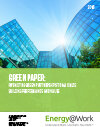EB Cx is an excellent means of obtaining the deep savings without sacrificing tenant comfort. However, too often EB Cx turns into a list of deficiencies – missing key elements such as functional tests, training for persistence, etc. The result is a report that sits on a shelf or becomes a list of trial and error tactics that do not achieve sustained savings. A properly structured EB Cx has 4 distinct phases: each with specific deliverables that must be checked and validated before moving to the next phase. 15% to 25% savings are achievable when properly coordinated with the operation team. With rising energy costs & available incentives – it makes sense to cut waste!
An Energy Audit is an equally great tool to identifying Energy Efficiency Measures (EEM) and should not be confused with EB Cx – each has value and a role to play in a properly structured Energy Management Action Plan (E-MAP).
The Audit and EB Cx will be explained individually using real world examples, case studies and an explanation of the difference between the two + the telltale signs that your building might make a good candidate and what to look for.
Presenters Included:
Scott Rouse
Managing Partner, Energy@Work Inc.
Scott Rouse is the founder and managing partner of Toronto-based Energy@Work Inc.
Scott is a Professional Engineer (P.Eng) in the Province of Ontario, Certified Energy Manager (CEM), Certified Measurement and Verification Professional (CMVP) and Certified Sustainable Development Professional (CSDP) with the Association of Energy Engineers. He specializes in commercial, industrial and institutional energy management and energy efficiency.
Michel Parent
Partner, Technosim
Michel Parent is a partner in a consulting engineering firm, Technosim, specializing in energy efficiency. Technosim has offices in Quebec and Ontario. Michel is specialized in energy efficiency in the commercial, institutional and industrial sectors. He is an Existing Building Recommissioning (EBCx) Agent and has performed recommissioning for over 5 million square feet of office and retail properties across Canada. He is also a certified Existing Building Commissioning Professional (EBCP).
For a copy of this presentation please complete the form submission on the Resources Page
^TOP






